Braces Brisbane
What orthodontics can do for you
At Orthosmile Orthodontics in Chermside, Aspley, Newmarket and Bulimba we offer a range of braces and appliances to cater to your orthodontic needs.
Orthodontic treatment involves the design and use of corrective appliances including braces, plates, rubber bands and headgear. These appliances move teeth by exerting a constant light force to them. When the appliances are tightened, the teeth receive more force. In response to force, a tooth will move gradually through the jaw bone.
Metal braces
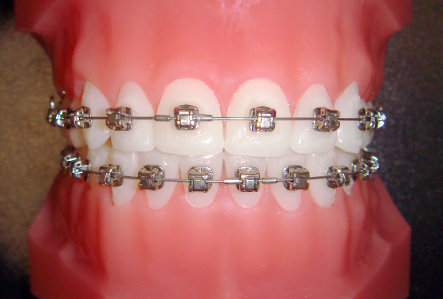
These are the most common type of braces. The brackets are much smaller than they used to be and kids can have fun choosing different coloured elastic bands to go with them.
Clear braces
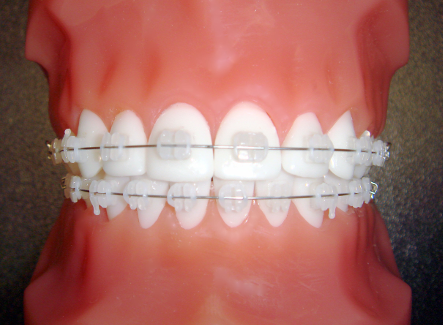
These braces are made of a ceramic material or sapphire crystals, and are very popular with adults because they are very difficult to see.
Invisible lingual braces
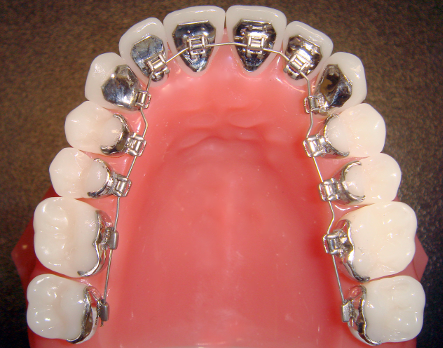
These braces are applied behind the teeth on the tongue side (lingual side) to straighten the teeth invisibly. They offer a highly cosmetic alternative to those patients who otherwise would not consider treatment.
Clear aligners
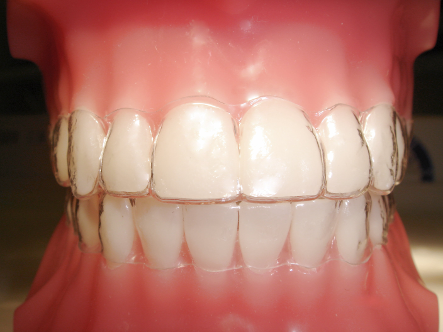
Clear removable aligners are used to straighten your teeth without wire or brackets. These clear, plastic aligners are not attached to your teeth and are manufactured by Invisalign and Clearsmile.
Diagram of braces
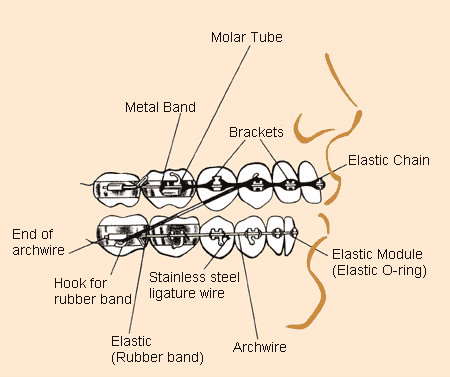
The archwire is a metal wire that is attached to the brackets and is used to move the teeth into proper alignment.
Brackets are small metal, ceramic, or plastic attachment bonded to each tooth with a tooth-coloured adhesive. The brackets help hold the archwire in place because each has a slot that the archwire fits into.
The archwire is held to each bracket with a small round elastic module/o-ring (this can come in various colours) or a twisted stainless steel ligature wire. When a stretchable series of elastic o-rings are connected together, they are called an elastic chain.
The metal band is the metal ring that is cemented to a tooth for strength and anchorage. A small metal bracket called a molar tube is usually welded to the cheek side of the molar band. The molar tube can also be bonded to a tooth without the use of a band.
Hooks are extensions of the bracket or band that are used for the attachment of rubber bands. During certain stages of treatment, small elastics (rubber bands) are worn to provide individual tooth movement or jaw alignment.
What to expect with braces
What to expect with braces
After initial placement of the braces, your lips will feel like they are sticking out. Your lips, tongue and cheeks will have to get accustomed to your new hardware. You may also feel general soreness in your mouth and teeth may be tender to biting pressures for three to seven days.
The teeth may be slightly mobile, since they will already be moving into their new corrected position. The discomfort mimics a pressure sensation or a dull ache. You should not feel anything sharp. This can be relieved by rinsing your mouth with a warm salt water mouthwash. Dissolve one teaspoonful of salt in a cup of warm water, and rinse your mouth vigorously. If the tenderness is severe, take whatever painkiller you normally take for headache or similar pain.
The lips, cheeks and tongue may also become irritated for one to two weeks as they toughen and become accustomed to the surface of the braces. Although orthodontic wax is available to help relieve you of the irritation and discomfort, we strongly advise you against using them so as to allow your cheeks and lips to adapt faster and get tougher against the braces. Nevertheless, if your supply of wax runs out, call our office for more.
A soft diet may be needed during these days, such as jelly, soups, soft casseroles, etc. until you feel more comfortable. Small bites and chewing on the back teeth may also help.
Retention and maintenance
At the completion of your orthodontic treatment, braces are removed and retainers are fitted to hold and support the teeth in their new position. These appliances may be removable plates or wires (bonded retainers) fitted behind your teeth. When teeth have been moved orthodontically they have a tendency to return to their original positions. This is why retainers play an important ongoing role in your orthodontic treatment. They are used to “retain” your teeth in their new position if they are not worn according to instructions, your teeth may move out of alignment.
The use of a retainer
All orthodontic patients at Dr Yeo’s office are instructed to wear retainers forever. Removable retainers are worn at night forever to ensure that a healthy bite and fabulous smile will be maintained for life. Studies and statistics have shown that teeth can and will move at any time. This variable pattern of gradual shifting, called maturational change, probably slows down after the early 20s, but still continues to a degree throughout life for most people. Even children whose teeth developed into ideal alignment and bite without treatment may develop orthodontic problems as adults. The most common maturational change is crowding of the lower incisor (front) teeth.
To ensure that your beautiful smile stays healthy, remember to continue to attend your general dentist for regular dental check-ups at least every six months even after you have finished your orthodontic treatment.
Wisdom teeth removal
Wisdom teeth are the 3rd of the large molar teeth at the back of the mouth and often those are tilted over so they won’t sit or function in the mouth correctly or in the growing phase they may push the other teeth around. The main indication for the removal of wisdom teeth is inflammation or infection of the gums around them. Careful studies have shown that wisdom teeth do not cause or contribute to the progressive crowding of lower incisor teeth that can develop in the late teen years and beyond. Your orthodontist, in consultation with your family dentist, can determine what is right for you.
Expansion appliances
An expander can be removable or fixed. Expansion is often used to widen the upper jaw and correct a cross-bite. A fixed expander is glued in and cannot be taken in and out by the patient. A fixed expander is attached to the upper back teeth and spans across the roof of the mouth. The expander (RME appliance) may have a screw device on the roof of the mouth that is activated (turned) by a family member with an expander key, as prescribed by Dr Yeo. For every activation or turn of the expander the upper jaw is expanded a quarter of a millimetre. Expansions of the upper jaw and teeth work best from ages 7 to 14 years old.
In some cases we will decide to use a quad helix appliance, this appliance does not require any turning or adjustment. The appliance is pre-adjusted and then inserted into the mouth. The appliance will expand the jaw on its own until it reaches a pre-set width. On the other hand, removable expanders are just like fixed expanders, the only difference is removable expanders can be taken in and out of the mouth during treatment. Treatment time with a removable expander versus a fixed expander generally takes longer.
Headgear
We try to keep the need to use a headgear down to an absolute minimum. However, there are some circumstances that require the use of a headgear.
A headgear is an orthodontic appliance used in the treatment of some patients. A headgear creates a push or pulling (depending on the type of head gear) force to guide the teeth and jaws into correct jaw alignment. The headgear is usually only worn at home and to sleep. A cervical pull, combination pull or high pull headgear are designed to correct certain forms of overjet (Class II). An overjet is characterized by the upper jaw “bucking” out over the lower jaw. Once a proper diagnosis is made the orthodontist will prescribe the headgear that will work best for your situation.
A reverse pull headgear (protraction headgear) is designed to correct an under bite or a (Class III) problem, particularly when a diagnosis of maxillary (upper jaw) deficiency (under development) is observed. An under bite is characterized by the lower jaw biting over the upper jaw. Protraction headgear therapy is often restricted to growing patients only. Adult (non-growing) patients are often ineligible for this type of treatment. In the majority of adult cases, surgical intervention is often needed to help achieve an ideal result.
Functional appliances
A functional appliance is used in certain types of orthodontic treatment. When the upper and lower jaws do not grow in harmony many problems may arise. These include protruding upper teeth, a receding chin/jaw, crossbite, a deep overbite, and a large overjet to name a few. A functional appliance works by redirecting or guiding growth of the teeth and jaws into proper alignment. Functional appliances can be fixed (eg. Herbst Appliance) or removable (eg. Twinblock Appliance or Bionator). They usually do not cause much discomfort, are easy to care for, and is just what your smile needs to look its best.
Braces Brisbane
To find out more about how the Orthosmile Orthodontics team can help you call us today.
